I remember those early morning lecture classes at the university, stuffed into a 1000-seat auditorium, listening to some professor drone on about American Government or Economics. Endlessly talking, boring us near-about to tears. Rambling on for an hour, tossing out random facts, figures and fluff, enough to overwhelm the senses.
I can only imagine a college curriculum centered around Ancient Civilizations…probably no more than a hodge-podge of prodigious maps, stippled with enough overlapping red lines and push-pins to resemble an army general’s ground plan for warfare. No doubt the lessons would be filled with mind-boggling dates to remember and legions of unfamiliar names to absorb. Sixty-minutes of daily yammering , flinging out uninteresting data like propaganda pamphlets scattered over European trenches in World War II.
Information that will be forgotten shortly after the final exam.
Instead, consider making the world your classroom.
Follow in the footsteps of ancient warriors. Peer out from the ramparts of their fortresses. Marvel at the sophistication of these by-gone civilizations. Stand in awe at their accomplishments in medicine and mathematics, art and engineering. Remember that they erected their magnificent monuments and constructed their tombs without the benefits of machines.
Be wowed by modern-day primitive cultures. Be entranced by their painted faces, tattooed flesh, and colorful clothing. Be impressed by their sometimes rudimentary, yet highly successful, methods of hunting, farming, and fishing, and embrace their traditions passed down from generation to generation. Remind yourself of their technological advancements in spite of their lack of technical gadgetry.
Learning through first-hand experiences will offer you maximum retention…long after your final test grades…long after the writing on your class notes has faded.
The Ancient Egyptians
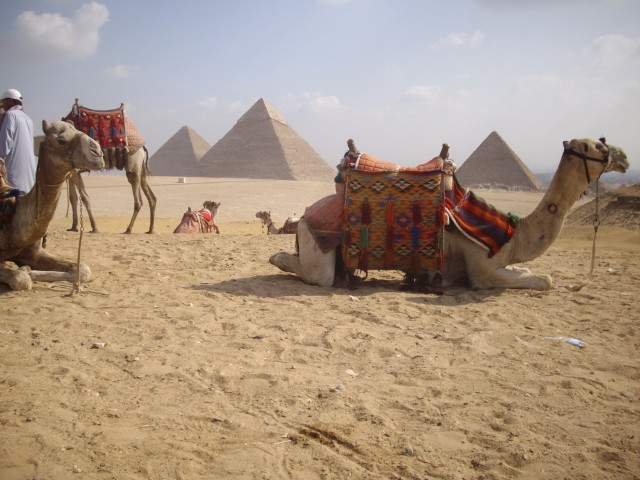
Straddle the hump of a persnickety camel and investigate the larger-than-life tombs of the Pharaohs – at the Giza Pyramids in Egypt.
“Mamá, you’re crushing me,” my 9-year old son Nicolas, who’s sitting in front of me, wails.
I am being hurled forward, almost over the saddle horn, as our dromedary struggles to get his elongated rear legs to a standing position. He spits and staggers to rise onto his front hooves. Still hanging on for dear life, we try to become accustomed to the camel’s special side-to-side swiveling gait. The tomb of Khufu yawns in front of us, with the early light of day glinting off the mortared stones. An ancient burial site, a sepulcher designed by master engineers and built with the sweat of paid, skilled laborers over the span of twenty years, the pyramids rise out of the broiling sand like silent sentinels watching over the nearby river Nile.
Learning through first-hand experiences will offer you maximum retention…long after your final test grades…long after the writing on your class notes has faded.
Back in Cairo, some 25 miles away, our private Egyptologist Heba escorts the three of us—my husband Gustavo, Nicolas and I—through the shimmering halls of the Egyptian Museum of Antiquities. Five-thousand years of magnificent history are on display—relics from the tomb of the boy-king Tutankhamun, golden chariots and gilded burial masks, artifacts unearthed from the Valley of the Kings, sarcophagi. We squeal like schoolchildren at the mummies, especially from the demonstration of “brain-scrambling,” as each cadaver is anointed with oil, wrapped in linens, and prepared for the afterlife.
Later in the week, a cruise along the Nile, south from Aswan, slowly shuttles us past the most splendid of Egypt’s monuments—the temples of Kom Ombo, dedicated to the crocodile god Sobek and Edfu, for its deity, Horus; then on to the immense pylons at Karnak, a religious site for worshipping Amun-Ra. At the ancient city of Thebes, known today as Luxor, tourists are greeted by gargantuan statues along the Avenue of the Rams and colorful souks surrounding the pagan shrines.
The Maya of Central America and Mexico
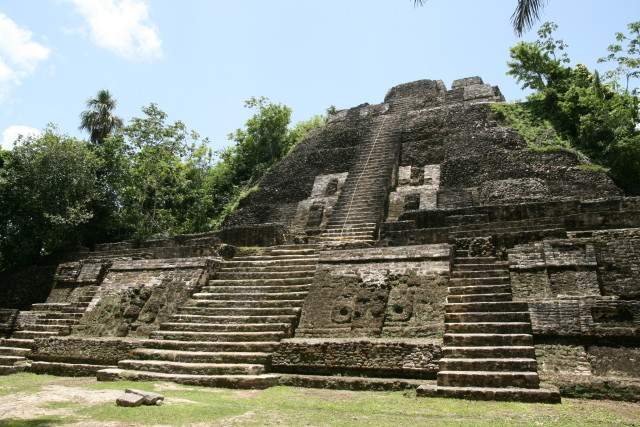
Board a jungle boat and cruise to the New River Bridge, in the interior of Belize, where the 700-plus structures of magnificent Mayan ruins at Lamanai lie scattered amongst 950 acres of rainforest preserve.
The river winds back and forth, with dozens of channels veering off in all directions. All too soon, our journey along this tributary ends, dumping us out on the banks of the New River Lagoon—the entrance to Lamanai. Translating to “submerged crocodile” in the Yucatec Mayan language, this incredible archaeological site extends into the pristine jungle ahead, undeniable proof of a thriving metropolis, inhabited around 1500BC.
We hike along a stony path, through dense woodland. The growling of a Howler monkey echoes through the cedar and mahogany trees. “Mask temple,” a sign announces. In the clearing ahead, a burial site, dating about 200BC, fans out: a pair of masks decorates the western façade of the temple. Cut from limestone block, the gargantuan humanoid face is sculpted with Olmec features (notably the upturned lip and broad nose). More than likely the visage of a Maya king, the relief is adorned with a headdress carving of a crocodile, giving credence to the translation of the ruins’ name.
They estimate that 40,000-60,000 Maya once lived inside the walls that constitute this now-forsaken city. As I tread across the mossy grass, I realize I’m treading on an ancient civilization…a civilization known for their achievements in architecture, math, and astronomy…an enigmatic society steeped in mystique and sacrifice. We continue through the jungle, toward the High Temple where these early Mesoamericans built a ceremonial sanctuary destined to touch the heavens, intended, perhaps, to reach the deities they worshiped. The deities they supplicated with daily offerings of food, or more rarely, animal or human blood…in exchange each morning for the rising of the sun.
I clamber to the top, while my son yells encouragement from the summit, 108 feet up. I wrestle with the rope, and my balance, to climb the steep terraces without falling. This High Temple has been excavated to near perfection, just as it was before the birth of Christ. I am awed by the perfect symmetry of the stones, hewn by the rugged hands of Pre-Columbian stonecutters. Laid precisely into position by indigenous masons two millenniums ago. From my vantage point here at the peak, I can see all the way to the New River Lagoon. Higher than the canopy of the rainforest. Higher than the keel-billed toucan roosting on a distant tree limb, in search of fruit. I wonder if a Maya family, like ours, stood on this very spot, gazing out across a fertile land.
The Inca of Peru
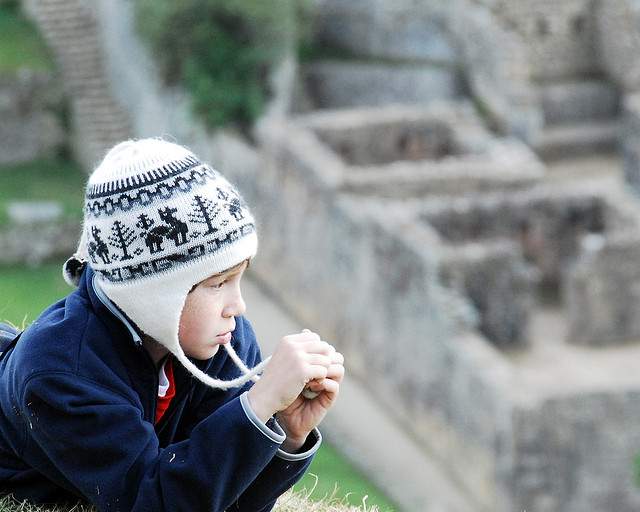
Ride the rails to the mysterious abandoned city of Machu Picchu, an Inca stronghold tucked away in the Andean Mountains, high above the Cusqueño streets.
Nicolas and I pause on the narrow streets of Cusco, Peru to have our pictures taken with a local woman draped in traditional garb and her llama. We pay a few soles for the privilege. The two of us and Gustavo are headed to the lovely courtyard of the Catholic convent of Santo Domingo. Its walls and arched entranceways are built over the foundations of Qorikancha, the main Inca temple, which honored Inti, the Supreme god–the god of the sun.
We are a couple days too early for the Inti Raymi festival, held every 24th of June at the fortress of Sachsayhuaman. But the festivities are in full swing, in expectation of the thousands of visitors who will swarm the fortaleza like honeybees, come for the multi-colored pageantry and theatrics, as actors re-enact the glorious days of the Incas. Neither the hordes of well-meaning tourists nor the ravaging earthquakes of Mother Nature can topple the stones of this archaic citadel.
The next morning, at the crack of dawn, we patiently wait in the Plaza de Armas of the quaint town of Aguas Calientes for the train, the luxury liner that will convey us 3 ½ hours of our journey to the “Lost City” – Machu Picchu. To the crowned jewel of the Inca civilization. Through low jungle, alongside babbling whitewater of a meandering river, our caravan carries us effortlessly over the tracks, on a pilgrimage to the terraced highlands of the sacred city. Wheat-like scrub and flowering grasses sway in the midday breeze. A pair of dappled llamas—one male and one female—scamper playfully along the steep ledges, undaunted and indifferent to our presence. High up in the Andes Mountains, at the most famous of all the ruins in Latin America, these ruminating pack animals roam free. Hidden in the clouds. Just like these mystic mountains, first discovered by Hiram Bingham in 1911, over three centuries after the collapse of their empire by the Spanish conquistadores.
The Selk’nam and Yamanas of Chile and Argentina
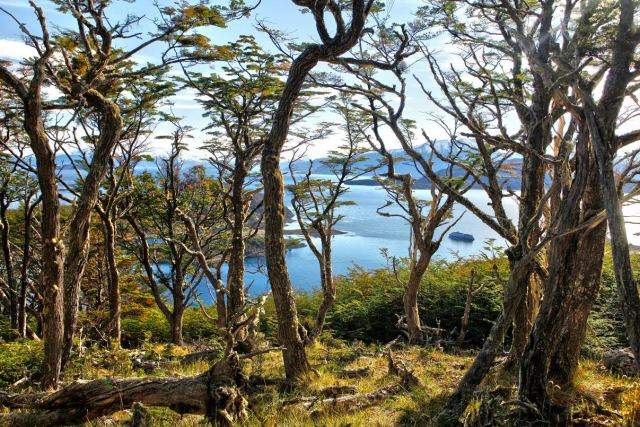
Depart on an expedition aboard an ice-cutting cruise ship to the remotest inhabited regions of the Southern Hemisphere, all the way to Cabo de Hornos, where the oceans merge.
I lean down to press my lips to the toe of the Selk’nam Indian, seated at the foot of the memorial statue of Hernando de Magallanes in Muñoz Gamero Plaza, the main square of downtown Punta Arenas. Legend says that this simple act will guarantee my return to Patagonia. Will guarantee my return to one of Chile’s southernmost cities.
Later that afternoon, my family of three boards the Mare Australis expeditionary cruise ship, heading toward the Strait of Magellan that bears the sculpture’s name. Heading in the direction of Cape Horn and Antarctica, through the alley of glaciers, past the snowy mountain peaks of the Darwin Cordillera. Eventually arriving at Wulaia Bay, home to the vanished aboriginal Indians–the Yamanás. Standing atop the overlook (only reached by an exhausting uphill trek), we gape, breathless, at the panoramic view of the Chilean fjords. It’s easy to understand why this terrain at the bottom-most tip of the American Continent, in Tierra del Fuego, was dubbed The Land of Fire by the Spaniards. As they stared out from their galleons at the blazing bonfires of Selk’nam tribesmen, this is the last vestige of the mainland before the North Pole.
At the brief stop in Puerto Williams, a naval base of Chile, we venture into the Martín Gusinde Anthropological Museum, founded in 1975. An archaeologist, this Austrian priest spent decades working tirelessly amongst the Yamaná and Selk’nam natives to understand their culture. His photographs grace the walls. Photographs of painted Indians in stripes of red, black and white, to mimic spirits. Pictures of these nomadic tribesmen as they hunted the guanaco (cousin to the llama) for its meat, plus geese, cormorants and penguins for their flesh, as well as their eggs. All to showcase this hunting-gathering society who eventually faded into extinction in the late 20th century.
The Kunas and Emberas of Panama
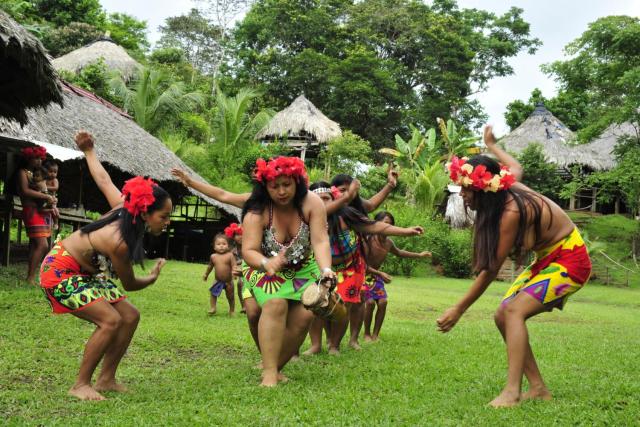
Travel by dugout to the thatched huts of the Embera Indian Tribe and stay overnight in a spartan hostel on the island of Wichub-Wala with the Kunas.
The rain pings off the aluminum sides of our motorized canoe like ammunition from a BB gun, as it sputters along the Chagres River. What has started off as gentle droplets of water quickly turns into a torrential downpour. While my husband and son help the Embera elder—our boat captain—bail the dugout, I do my best to protect our cameras and video equipment.
We finally make it up-river to the settlement. The dirt path to the thatched huts, normally easily accessible, has become a muddy quagmire. Soaked to the bone, we scurry inside the primitive lodge. In spite of our drenching, a delightful afternoon of dining (sampling local foods) and dancing brightens our mood. I even let Gustavo and Nicolas get matching temporary tattoos, made from guagua juice. I’m hoping, with all the gaiety and laughter, that my son won’t notice the bared breasts of some of the older Embera women. “It’s their culture,” is what I plan to say. “A little more primal than ours.”
And speaking of primal…a day later, we steer toward the San Blás islands: a 232-mile strip of coastline with 365 islands governed by the indigenous Kuna Indian tribe, which has been calling my name for over two decades. The tiny outrigger makes slow headway against the choppy waters of the Caribbean. Only when our Kuna guide revs the engine does the little dinghy forge through the surf. Saltwater spray sullies my glasses.
Off the northern shores of Panamá, scattered for hundreds of miles in the archipelago, the indigenous Indians live exactly as their ancestors did. Grizzled grandfathers, stooped with age, and teenage youth alike, cast nets from the pier. Side by side, they hurl their knotted ropes into the open ocean in the hopes of snaring the bounty of the sea. An elderly Kuna women, dressed in colorful clothes and wini beads, puts the finishing touches on the mola she’s sewing. One stitch…two…gnarled, yet still nimble, fingers weave the needle through the multiple layers of bright fabric. Making intricate patterns across the bodice of the blouse she’s fashioning for sale. If she’s lucky, she’ll sell one of her creations to the next arrival on the tourist boat. If not, she’ll settle for selling her smile: it costs one dollar-U.S. currency or a balboa—to snap her picture for your photo album back home.
The Aborigines of Australia
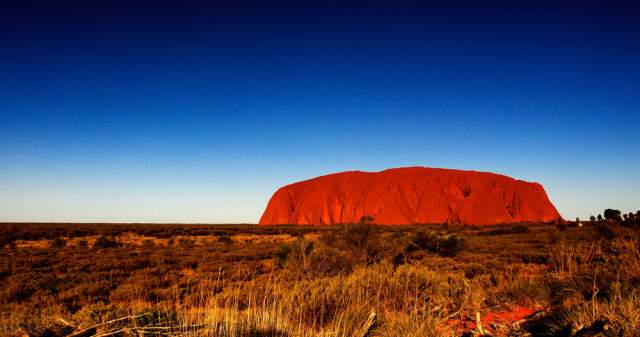
Trace your footprints in the ruby-colored sand at Ayers Rock, as aborigines from the Outback enlighten you with their flourishing culture and time-honored traditions.
Daylight dances across the 9.4 km circumference and 348 meters of height of Uluru, the iconic symbol of Australia’s rugged outback. The rays of the morning sun wash over Ayers Rock and the surrounding crimson sand in sparkling hues of orange and gold. For 40,000 years, the aborigines have lived here in the Western Desert, on this spiritual and hallowed land, with Uluru at the epicenter, as its pulsating, beating heart.
With our Anangu guide from the nearby community, we begin our walk around the base of the enormous sandstone monolith. Still glowing red from the sunrise. With veneration, our guide details how this massive landmark was created by “spirit ancestors in the dreamtime.” Shutters click and video cameras whir, trying to canonize – on film – the aboriginal reverence for this sacred ground. If only his admiration could be transferred to the visual page.
Around a blazing bonfire, we relive the mythology of Australia’s indigenous natives and learn their time-honored bush skills. We witness the beauty of their dot-painting art (much of it used for body painting as ceremonial decoration), their renowned ability of rubbing two sticks together for smoke, followed by conflagration, and their dexterity at hunting with a spear, though nowadays rifles have replaced the traditional lance. Tonight, we’ll return for a campfire dinner on the barbie of outback delicacies: barramundi (a delectable sport-fish), kangaroo, crocodile, even emu. Compliments of the country’s rural Northern Territory.
So go ahead. Make the world your oyster. Glean those pearls of knowledge from every corner of the globe.
Ancient Civilizations 101.
Tulum and Chichen Itza, Mexico…Tikal, Guatemala…Copán, Honduras…Altun Ha, Belize.
Vanished civilizations 101.
The Khmer Dynasty of Angor, in Cambodia, who left an intricate palace of worship dedicated to their divine Vishnu…Polynesian natives of Chile’s Easter Island, with their strange ‘Moai’ statues…the Anasazi of New Mexico, whose cliff dwellings at Mesa Verde shed light on these ‘pueblo people’.
Primitive Societies 101.
The Surmas of Ethiopia with their oversized lip plugs…natives of Papua, New Guinea with their cannibalistic traditions…the Amazonians of Brazil, inhabiting the world’s largest rainforest…and the Sentinelese of India, living in the Bay of Bengal, who managed to weather the unprecedented tsunami of 2004, unscathed.
Just remember, encounters with the living and real-world glimpses into the societies of the past beat lecture classes any day of the week.
Do you incorporate education into your travels? Formally or informally? Share your thoughts below.
Read more about the connection between travel and education:
- Long-Term Travel As Education
- MBA vs. RTW
- Honoring the Lessons Travel Teaches
- Higher Education for Free
- Lessons From Around the Globe
Photo credits: Wikimedia, Wikimedia, Wikimedia, Dancing, Stanislav Fosenbauer, sunsinger, Wuluaia Bay photo courtesy of the author and may not be used without permission.